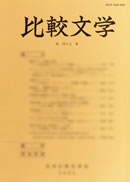2 巻
選択された号の論文の21件中1~21を表示しています
- |<
- <
- 1
- >
- >|
紙碑
-
1959 年 2 巻 p. 1-3
発行日: 1959/09/01
公開日: 2017/07/31
PDF形式でダウンロード (677K) -
1959 年 2 巻 p. 4-10
発行日: 1959/09/01
公開日: 2017/07/31
PDF形式でダウンロード (1939K) -
1959 年 2 巻 p. 11-14
発行日: 1959/09/01
公開日: 2017/07/31
PDF形式でダウンロード (1103K) -
1959 年 2 巻 p. 15-22
発行日: 1959/09/01
公開日: 2017/07/31
PDF形式でダウンロード (2110K)
論文
-
1959 年 2 巻 p. 23-32
発行日: 1959/03/31
公開日: 2017/06/17
PDF形式でダウンロード (2909K) -
1959 年 2 巻 p. 33-39
発行日: 1959/03/31
公開日: 2017/06/17
PDF形式でダウンロード (2744K) -
1959 年 2 巻 p. 40-49
発行日: 1959/03/31
公開日: 2017/06/17
PDF形式でダウンロード (3809K) -
1959 年 2 巻 p. 50-59
発行日: 1959/03/31
公開日: 2017/06/17
PDF形式でダウンロード (3779K) -
1959 年 2 巻 p. 60-78
発行日: 1959/03/31
公開日: 2017/06/17
PDF形式でダウンロード (6053K)
研究ノート
-
1959 年 2 巻 p. 79-86
発行日: 1959/03/31
公開日: 2017/06/17
PDF形式でダウンロード (2752K)
報告
-
1959 年 2 巻 p. 87-90
発行日: 1959/09/01
公開日: 2017/07/31
PDF形式でダウンロード (1603K)
書評
-
1959 年 2 巻 p. 91-92
発行日: 1959/09/01
公開日: 2017/07/31
PDF形式でダウンロード (788K) -
1959 年 2 巻 p. 92-93
発行日: 1959/09/01
公開日: 2017/07/31
PDF形式でダウンロード (795K) -
1959 年 2 巻 p. 93-94
発行日: 1959/09/01
公開日: 2017/07/31
PDF形式でダウンロード (812K) -
1959 年 2 巻 p. 94-97
発行日: 1959/09/01
公開日: 2017/07/31
PDF形式でダウンロード (1695K) -
1959 年 2 巻 p. 97-99
発行日: 1959/09/01
公開日: 2017/07/31
PDF形式でダウンロード (1271K) -
1959 年 2 巻 p. 99-102
発行日: 1959/09/01
公開日: 2017/07/31
PDF形式でダウンロード (1536K) -
1959 年 2 巻 p. 102-103
発行日: 1959/09/01
公開日: 2017/07/31
PDF形式でダウンロード (583K)
資料
-
1959 年 2 巻 p. 115-140
発行日: 1959/09/01
公開日: 2017/07/31
PDF形式でダウンロード (9324K) -
1959 年 2 巻 p. 141-179
発行日: 1959/09/01
公開日: 2017/07/31
PDF形式でダウンロード (5419K)
-
1959 年 2 巻 p. 184-179
発行日: 1959/09/01
公開日: 2017/07/31
PDF形式でダウンロード (1133K)
- |<
- <
- 1
- >
- >|
